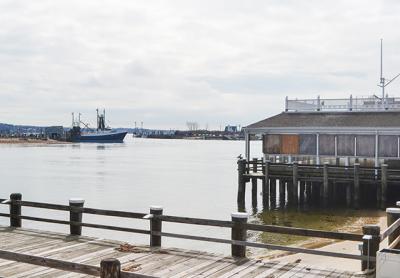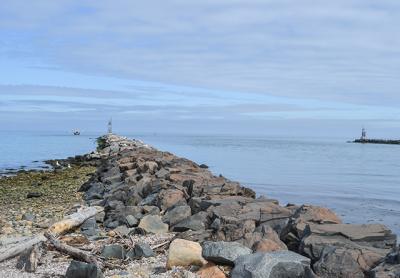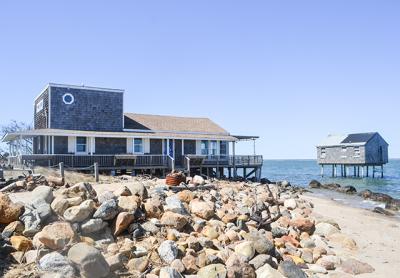Partnership Steps Up to Restore the Sag Harbor Cinema
Partnership Steps Up to Restore the Sag Harbor Cinema

Sag Harbor could get its cinema back. A community organization has entered into a contract with the owner of the Sag Harbor Cinema property four months after part of the iconic building was destroyed by fire. Fund-raising to seal the deal has now officially begun.
The Sag Harbor Partnership, a group that formed more than a year ago to help create a municipal park in the village, announced this week that after months of negotiations a contract has been signed to buy the property from Gerald Mallow, its longtime owner. The price: $8 million.
April Gornik, a North Haven artist and community activist who is the vice president of the partnership and led the charge, said they have until the end of the year to close.
Time is of the essence, she said by phone on Tuesday. They have until about July, when a big fund-raiser is planned, to decide "if what we're looking at in terms of pledges is substantial enough to go forward." One anonymous donor has already pledged $1 million.
A wind-fueled fire ripped through a section of Sag Harbor's Main Street on Dec. 16, ultimately destroying two buildings, including the Sag Harbor Cinema, and badly damaging others, devastating businesses and displacing two people from second-story apartments.
Flames gutted the lobby of the cinema, leaving the Art Deco facade in danger of collapse. Officials tore down the lobby that very night. The theater portion of the 1930s building, with a large screen and located at the back of the L-shaped structure, remained standing. Officials said it had smoke damage only. The theater's neon "Sag Harbor" sign, an 11-year-old replica of the original and considered a village landmark, was saved and is being kept in a nearby storage facility.
"We think it's really important to give our community back what it lost," Ms. Gornik said. "It really was the heart of this place in a big way."
The partnership plans not only to rebuild, but to establish a Sag Harbor Cinema Arts Center. The not-for-profit would expand on the cinema's tradition of art house film programming with educational initiatives for school-age children and residents.
Ms. Gornik said estimates for the construction project are $4 million to $5 million at a minimum.
Plans include rebuilding the facade and repairing the sign, and rebuilding and repurposing some of the space. The group plans to preserve the "curved scope" screen currently in the 480-seat theater, though Ms. Gornik said no one from the group had yet been able to get inside to assess the damage.
The group has plans for two theaters. A larger one would seat about 250 people, another about 150. A private screening room with 30 seats is planned for the second floor above Main Street. It would also serve as a classroom.
"We want to do programming that will serve a really wide range of people and age groups," Ms. Gornik said.
The cinema has long been for sale, and the idea of purchasing it for community use is nothing new. The asking price was $14 million before the fire. Several members of the partnership have been trying to buy it, to ensure it remained a cinema, since 2009.
"We were concerned that we'd lose it to some big business, and Main Street would be irrevocably changed," Ms. Gornik said in a press release.
Giulia D'Agnolo Vallan, a member of the selection committee for the Venice Film Festival, and Andrew Fierberg, a movie producer, came up with the original vision for the cinema arts foundation, Ms. Gornik said.
The small group reconvened in July, when, Ms. Gornik said, Mr. Mallow expressed an interest in having the cinema purchased by someone who wanted to preserve it. Architectural and structural reports were drawn up.
"We were set to be in contract by the end of December, when the fire threw everything into disarray, but we didn't lose hope," she said. The group forged ahead, working with experts on how best to rebuild the cinema, make it profitable, and serve the community. "We're grateful that Gerry stuck with us."
"The Cinema Arts Center will provide an opportunity to draw on the talents and experiences of an ever-expanding year-round community on the East End," Susan Lacy, a filmmaker, creator of the "American Masters" series on PBS, and Noyac homeowner, said in the release.
The partnership's Big Tent party, to be held on Long Wharf on July 16, will serve as a fund-raiser and honor Mr. Mallow. The partnership's inaugural party last year raised more than $130,000, which was donated to the Village of Sag Harbor to help its efforts to establish a waterfront park.
Once money for the purchase has been secured, a capital campaign will begin for the construction. Grant money may also be available.
"We are fortunate to live in a community where so many people are giving of their time, talent, and money toward restoring such a cultural treasure," said Nick Gazzolo, the president of the partnership. "Main Street won't feel whole until that famous sign is shining again. Everyone wants to see this comeback."
Contributions to the project will be tax-deductible and can be made to the Sag Harbor Partnership.









